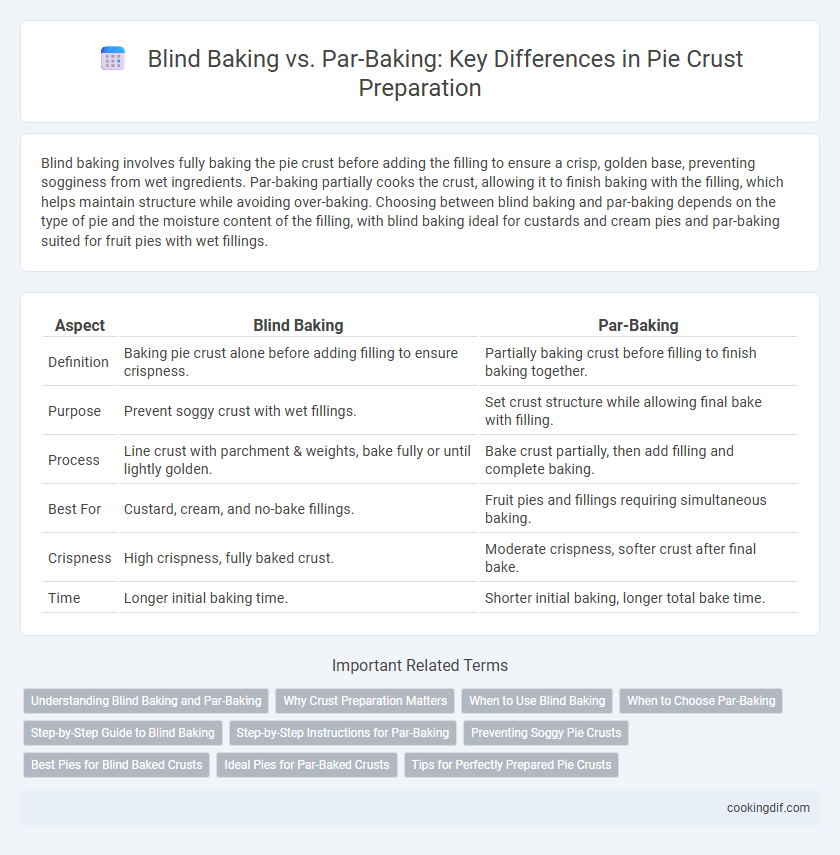Blind baking involves fully baking the pie crust before adding the filling to ensure a crisp, golden base, preventing sogginess from wet ingredients. Par-baking partially cooks the crust, allowing it to finish baking with the filling, which helps maintain structure while avoiding over-baking. Choosing between blind baking and par-baking depends on the type of pie and the moisture content of the filling, with blind baking ideal for custards and cream pies and par-baking suited for fruit pies with wet fillings.
Table of Comparison
| Aspect | Blind Baking | Par-Baking |
|---|---|---|
| Definition | Baking pie crust alone before adding filling to ensure crispness. | Partially baking crust before filling to finish baking together. |
| Purpose | Prevent soggy crust with wet fillings. | Set crust structure while allowing final bake with filling. |
| Process | Line crust with parchment & weights, bake fully or until lightly golden. | Bake crust partially, then add filling and complete baking. |
| Best For | Custard, cream, and no-bake fillings. | Fruit pies and fillings requiring simultaneous baking. |
| Crispness | High crispness, fully baked crust. | Moderate crispness, softer crust after final bake. |
| Time | Longer initial baking time. | Shorter initial baking, longer total bake time. |
Understanding Blind Baking and Par-Baking
Blind baking involves pre-baking the pie crust without filling to ensure a crisp, fully cooked base, preventing sogginess from wet fillings. Par-baking partially bakes the crust, leaving it slightly soft to finish baking with the filling, ideal for custard or cream pies that require combined baking. Both techniques optimize crust texture and structural integrity based on the pie's filling type and baking requirements.
Why Crust Preparation Matters
Proper crust preparation is crucial for achieving a flaky, tender pie base that holds fillings without becoming soggy. Blind baking involves pre-baking the crust fully to ensure a crisp texture, ideal for custard or cream pies, while par-baking partially cooks the crust, maintaining structure for fruit or moist fillings. Understanding the differences ensures optimal moisture control, texture, and overall pie quality.
When to Use Blind Baking
Blind baking is essential when preparing pie crusts for fillings that require minimal or no baking time, such as custards or cream pies; this process prevents a soggy bottom by fully pre-baking the crust. Use blind baking for delicate fillings like lemon meringue or chocolate silk, where the crust must be crisp before adding the filling. This technique involves lining the crust with parchment and weights to maintain shape during the high-heat bake.
When to Choose Par-Baking
Par-baking is ideal when the pie filling requires less baking time than the crust, such as with custard or fruit pies. This method ensures the crust is partially cooked and remains crisp, preventing sogginess from wet fillings. Choose par-baking for pies with delicate fillings that need gentle baking to avoid overcooking the crust.
Step-by-Step Guide to Blind Baking
Blind baking involves pre-baking the pie crust before adding the filling to prevent sogginess and ensure a crisp base. Begin by rolling out the dough, placing it in the pie dish, and piercing the bottom with a fork to allow steam to escape. Line the crust with parchment paper or aluminum foil, fill it with pie weights or dried beans, bake at 375degF (190degC) for 15 minutes, remove the weights and lining, then bake an additional 5 to 7 minutes until golden brown.
Step-by-Step Instructions for Par-Baking
Preheat the oven to 375degF (190degC) and line the pie crust with parchment paper or aluminum foil, then fill it with pie weights or dried beans to prevent puffing. Bake the crust for 15 minutes, carefully remove the weights and liner, then bake for an additional 5-7 minutes until the edges turn golden brown. This par-baking method ensures a crisp bottom crust that holds fillings without becoming soggy.
Preventing Soggy Pie Crusts
Blind baking involves pre-baking the pie crust fully before adding the filling, creating a firm barrier that prevents sogginess from wet fillings. Par-baking partially bakes the crust, allowing it to set while still finishing baking with the filling, offering a balance between crispness and tenderness. For preventing soggy pie crusts, blind baking is generally more effective with custard or cream pies, while par-baking suits fruit pies where the filling cooks alongside the crust.
Best Pies for Blind Baked Crusts
Blind baking involves fully baking the pie crust before adding the filling to prevent sogginess, making it ideal for no-bake or custard pies like key lime, pumpkin, and chocolate silk. Par-baking partially cooks the crust, providing a stable base for fillings that require further baking, such as fruit pies and quiches. Blind baked crusts excel with delicate fillings that need a crisp, fully baked base to maintain texture and flavor integrity.
Ideal Pies for Par-Baked Crusts
Par-baking is ideal for pies with moist fillings like custard, pumpkin, or cream pies to prevent a soggy crust and ensure even baking. This technique partially bakes the crust before adding the filling, maintaining a crisp, golden texture. Pies such as chocolate mousse, key lime, and pecan often benefit from par-baked crusts for a stable, crunchy base.
Tips for Perfectly Prepared Pie Crusts
Blind baking involves fully baking the pie crust before adding the filling, ensuring a crisp and firm base ideal for custard or cream pies. Par-baking partially bakes the crust, allowing it to finish cooking with the filling, perfect for fruit pies that require less bake time. Using pie weights or dried beans during blind baking prevents shrinkage and bubbles, while docking the dough helps steam escape and maintains an even texture.
Blind baking vs par-baking for crust preparation Infographic

 cookingdif.com
cookingdif.com